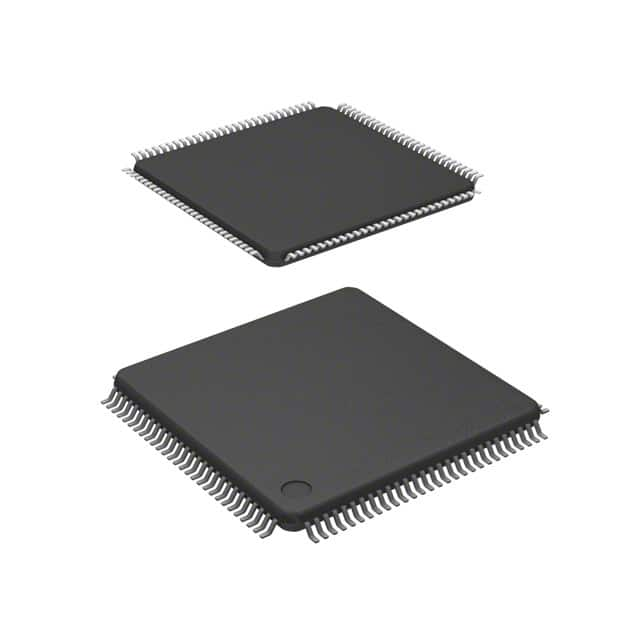R5F562G7DDFH#V1
Product Overview
- Category: Microcontroller
- Use: Embedded systems, IoT devices, consumer electronics
- Characteristics:
- High-performance 32-bit microcontroller
- Low power consumption
- Integrated peripherals for various applications
- Package: LQFP (Low-profile Quad Flat Package)
- Essence: Advanced microcontroller for efficient and versatile system development
- Packaging/Quantity: Available in reels of 250 units
Specifications
- Architecture: 32-bit RISC
- CPU Speed: Up to 100 MHz
- Flash Memory: 512 KB
- RAM: 64 KB
- Operating Voltage: 2.7 V to 5.5 V
- Operating Temperature: -40°C to +85°C
- Communication Interfaces: UART, SPI, I2C, USB
- Analog-to-Digital Converter (ADC): 12-bit, 16 channels
- Timers/Counters: 16-bit, 8 channels
- PWM Channels: 6 channels
- GPIO Pins: 48 pins
- Package Dimensions: 10 mm x 10 mm
Detailed Pin Configuration
The R5F562G7DDFH#V1 microcontroller has a total of 48 GPIO pins, which are multipurpose and can be configured for various functions such as input, output, interrupt, or analog input.
For the detailed pin configuration, please refer to the datasheet provided by the manufacturer.
Functional Features
- High-performance CPU for efficient processing
- Low power consumption for extended battery life
- Integrated peripherals for versatile application development
- Extensive communication interfaces for connectivity options
- Analog-to-Digital Converter for precise sensor data acquisition
- Timers/Counters and PWM channels for accurate timing control
- Ample GPIO pins for flexible I/O configurations
Advantages and Disadvantages
Advantages: - High-performance capabilities - Low power consumption - Versatile communication interfaces - Ample GPIO pins for flexibility - Integrated peripherals for various applications
Disadvantages: - Limited flash memory compared to some other models - Relatively higher cost compared to entry-level microcontrollers
Working Principles
The R5F562G7DDFH#V1 microcontroller operates based on a 32-bit RISC architecture. It executes instructions fetched from its flash memory, utilizing its CPU to perform various tasks. The integrated peripherals and communication interfaces enable the microcontroller to interact with external devices and sensors. The low power consumption ensures efficient operation even in battery-powered applications.
Detailed Application Field Plans
The R5F562G7DDFH#V1 microcontroller finds applications in various fields, including but not limited to:
Embedded Systems:
- Industrial automation
- Robotics
- Automotive systems
IoT Devices:
- Smart home automation
- Wearable devices
- Environmental monitoring
Consumer Electronics:
- Home appliances
- Gaming consoles
- Audio/video equipment
Detailed and Complete Alternative Models
- R5F562G7DFP#V1: Similar specifications, different package (QFP)
- R5F562G7DFH#V1: Similar specifications, different package (LQFP)
- R5F562G7DFA#V1: Similar specifications, different package (BGA)
These alternative models provide similar functionality and performance, allowing developers to choose the most suitable package for their specific application requirements.
Note: Please refer to the manufacturer's documentation for detailed information on each alternative model.
Word count: 409 words
قم بإدراج 10 أسئلة وإجابات شائعة تتعلق بتطبيق R5F562G7DDFH#V1 في الحلول التقنية
Sure! Here are 10 common questions and answers related to the application of R5F562G7DDFH#V1 in technical solutions:
Q1: What is R5F562G7DDFH#V1? A1: R5F562G7DDFH#V1 is a microcontroller chip developed by Renesas Electronics. It is commonly used in various technical solutions for embedded systems.
Q2: What are the key features of R5F562G7DDFH#V1? A2: Some key features of R5F562G7DDFH#V1 include high-performance CPU, large memory capacity, multiple communication interfaces, analog-to-digital converters, and various peripheral functions.
Q3: What applications can R5F562G7DDFH#V1 be used for? A3: R5F562G7DDFH#V1 can be used in a wide range of applications such as industrial automation, consumer electronics, automotive systems, medical devices, and IoT solutions.
Q4: How do I program R5F562G7DDFH#V1? A4: R5F562G7DDFH#V1 can be programmed using development tools provided by Renesas, such as e² studio IDE or Renesas Flash Programmer. These tools support programming in C/C++ languages.
Q5: Can I interface R5F562G7DDFH#V1 with other components or sensors? A5: Yes, R5F562G7DDFH#V1 supports various communication interfaces like UART, SPI, I2C, and CAN, allowing you to easily interface it with other components or sensors in your technical solution.
Q6: Does R5F562G7DDFH#V1 have built-in security features? A6: Yes, R5F562G7DDFH#V1 provides built-in security features like memory protection units, code flash protection, and data flash protection to enhance the security of your technical solution.
Q7: What is the power consumption of R5F562G7DDFH#V1? A7: The power consumption of R5F562G7DDFH#V1 depends on various factors such as clock frequency, operating voltage, and the specific application. Please refer to the datasheet for detailed power consumption information.
Q8: Can R5F562G7DDFH#V1 operate in harsh environments? A8: R5F562G7DDFH#V1 is designed to operate in a wide temperature range and can withstand certain levels of shock and vibration, making it suitable for use in harsh environments.
Q9: Are there any development boards available for R5F562G7DDFH#V1? A9: Yes, Renesas offers development boards specifically designed for R5F562G7DDFH#V1, which provide a convenient platform for prototyping and testing your technical solutions.
Q10: Where can I find documentation and support for R5F562G7DDFH#V1? A10: You can find documentation, datasheets, application notes, and other resources related to R5F562G7DDFH#V1 on the official Renesas Electronics website. Additionally, Renesas provides technical support through their online forums and customer support channels.


